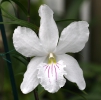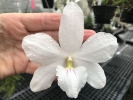|
|
|
|
|
| |
Established Seedlings of
Dendrobium papilio 'Vistamont' AM/AOS (large-flowered form) × 'Skipper' (large-flowered form) |
|
| |
|
|
| |
| Number: |
TN8715 |
| Name: |
Dendrobium papilio 'Vistamont' AM/AOS (large-flowered form) × 'Skipper' (large-flowered form)
|
| Type: |
outcross (What's that?) |
|
Seed Donor: |
Ms Cynthia Hill
|
|
Click to Enlarge

Pod Parent Flower |
Click to Enlarge

Pod Parent Blooming Plant |
Click to Enlarge

Pollen Parent Flower |
|
|
|
| |
Culture Notes from Donor: Pod parent plant: Temperature range Warm-Intermediate 87-64°F, cooler season Cool-Intermediate 75-58°F. Best grown mounted, in my opinion, because canes become pendent with age, and flowers weigh them down. Intermediate light, good air movement, water daily in growing season, twice a week during winter. Observe root tips - when green, water copiously, when velamen covers tips, water every third day. Regular fertilizer during growing season, fertilize once a month during winter.
Mounted on a hardwood stick, roots exposed, a little inch wood slat basket with small amount of New Zealand sphagnum draped on top where roots meet stick.
Pollen parent plant: Temperature range Warm-Intermediate 87-64°F, cooler season Cool-Intermediate 75-58°F. Well suited to mounting or basket culture, as canes become pendent with age and from weight of flowers. Intermediate light, good air movement, water daily in growing season, twice a week during winter. Observe root tips - when green, water copiously, when velamen covers tips, water every third day. Regular fertilizer during growing season, fertilize once a month during winter.
Basketed in a 4 inch wood slat basket with small amount of New Zealand sphagnum.
Comments: Pod parent plant: Native to the Philippines, where it grows as an epiphyte 4600-7250 ft. An astonishing sight in bloom, with flowers twice the size of the typical form of the species, natural spread of over 4 inches. Flowers are paper-white with some pink/purple markings on lip; they appear fragile, but will stay in good condition for 10 days or more if water is kept off the blooms. The name 'papilio' refers to their butterfly-like appearance, suspended in air.
For additional origin/habitat information supplied courtesy of
Charles and Margaret Baker, see further below, near the bottom of this page.
|
Temperatures we attempt to use in the lab & greenhouse:
| For Species: |
|
Spring, Summer, Autumn, Winter: days average 69°F, nights 53°F; best fit is Cool 70-52°F
(Source:
Baker's Web OSC) |
|
About the name...
| Etymology of |
Dendrobium |
|
From Greek "dendron" tree and "bios" life.
(Source:
Pridgeon 1992) |
| Etymology of |
papilio |
|
From Latin "papilio" butterfly.
(Source:
Brown 1956) |
| Pronunciation of |
Dendrobium |
|
den-DRO-bee-um
(Source:
Pridgeon 1992) |
| Pronunciation of |
papilio |
|
pa-PIL-ee-oh
(Source:
Hawkes 1978) |
|
If you would like to direct someone to this web page, please copy and paste this URL into your email:
http://troymeyers.com/d?128715
|
ESTABLISHED SEEDLINGS
of these are not currently available, but we have some maturing in the greenhouse and expect to offer them in the future.
There are 3 items with
1 to 9 plants per
item
(1 is a compot) that will be considered for sale later.
Click here to see if we have flasks available.
|
|
|
| |
The origin/habitat information below is supplied courtesy of Charles and Margaret Baker
The following information is based on the name of the plant provided by the donor, and assumes that the name is correct. If the plant has been misidentified, then the following information may not be correct.
This text is copyrighted by the Bakers and may not be reproduced without permission.
ORIGIN/HABITAT: The Philippines. On Luzon Island, plants are reported in
Albay and Benguet Provinces. On Mindanao, they are found in Davao and
Surigao Provinces. They are also found on Negros in Negros Oriental, These
plants grow on mossy, forest trees at 4600-7200 ft. (1400-2200 m).
More about this information and the Bakers...
|
|
|
| |
|
|
|